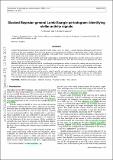Stacked Bayesian general Lomb-Scargle periodogram : identifying stellar activity signals
Abstract
Context. Distinguishing between a signal induced by either stellar activity or a planet is currently the main challenge in radial velocity searches for low-mass exoplanets. Even when the presence of a transiting planet and hence its period are known, stellar activity can be the main barrier to measuring the correct amplitude of the radial velocity signal. Several tools are being used to help understand which signals come from stellar activity in the data. Aims. We aim to present a new tool that can be used for the purpose of identifying periodicities caused by stellar activity, and show how it can be used to track the signal-to-noise ratio (SNR) of the detection over time. The tool is based on the principle that stellar activity signals are variable and incoherent. Methods. We calculate the Bayesian general Lomb-Scargle periodogram for subsets of data and by adding one extra data point we track what happens to the presence and significance of periodicities in the data. Publicly available datasets from HARPS and HARPS-N were used for this purpose. Additionally, we analysed a synthetic dataset that we created with SOAP2.0 to simulate pure stellar activity and a mixture of stellar activity and a planet. Results. We find that this tool can easily be used to identify unstable and incoherent signals, such as those introduced by stellar activity. The SNR of the detection grows approximately as the square root of the number of data points, in the case of a stable signal. This can then be used to make decisions on whether it is useful to keep observing a specific object. The tool is relatively fast and easy to use, and thus lends itself perfectly to a quick analysis of the data.
Citation
Mortier , A & Cameron , A C 2017 , ' Stacked Bayesian general Lomb-Scargle periodogram : identifying stellar activity signals ' , Astronomy & Astrophysics , vol. 601 , A110 . https://doi.org/10.1051/0004-6361/201630201
Publication
Astronomy & Astrophysics
Status
Peer reviewed
ISSN
0004-6361Type
Journal article
Description
The research leading to these results received funding from the European Union Seventh Framework Programme (FP7/2007-2013) under grant agreement number 313014 (ETAEARTH). ACC acknowledges support from STFC grant ST/M001296/1.Collections
Items in the St Andrews Research Repository are protected by copyright, with all rights reserved, unless otherwise indicated.

